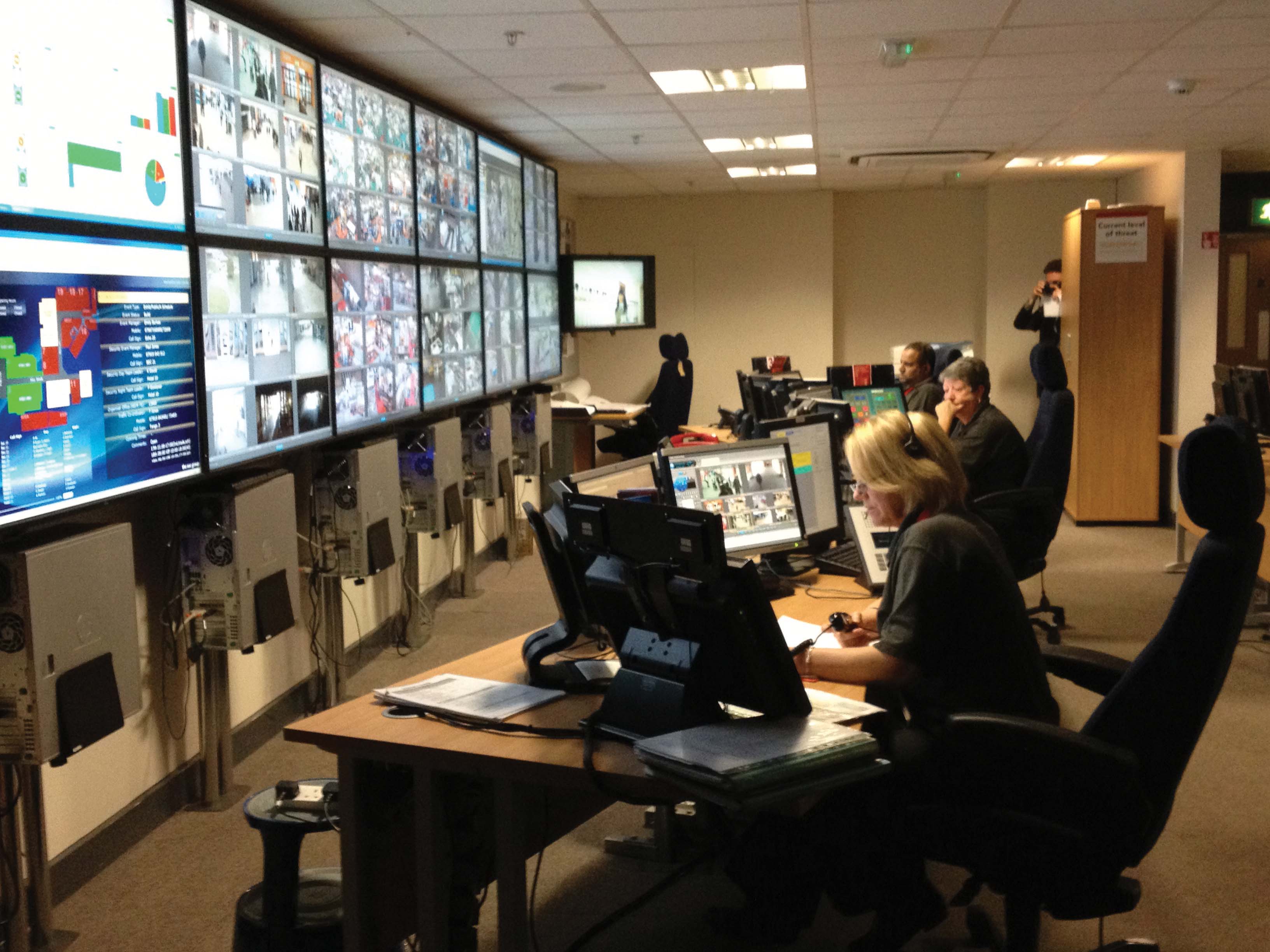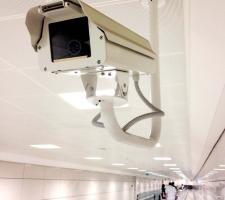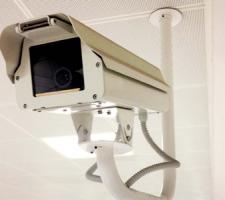
Control room staff can remotely monitor several sites
David Lenot examines how mass transit agencies can benefit from IP access control and the features required to ensure a sound investment.
With millions of commuters relying on their services daily, mass transit agencies are faced with the unfortunate reality that their operations are susceptible to threats. A single incidence of unauthorised access to restricted areas and buildings could be the catalyst to damaged property, endangered lives or other unfortunate events.
Unlike an international airport which typically comprises of one massive location with completely restricted access to back-end operations, mass transit agencies have a very different set of challenges. Their security teams are responsible for protecting dozens if not hundreds of stations and electrical substations spread throughout an urban area. They also have to balance passenger’s accessibility to their facilities with restricting critical areas such as tunnels, control rooms, utility rooms, power supplies, or hazardous-material storage areas. Beyond these locations, their security initiatives also encompass other sites such as corporate offices, central control stations, maintenance and repair locations, equipment storage and fleet parking facilities.
In response, mass transit organisations have made concerted efforts to upgrade their security programs, paying particular attention to their doors and many authorities are implementing IP access control solutions to better control physical access to their most critical areas and facilities.
IP access control provides mass transit agencies with faster and more efficient communication between software and hardware, using the existing corporate networks. By adopting IP access control, mass transit organisations can better manage their physical access points by configuring and controlling the various door peripherals over any IP network.
Furthermore, wiring installation and labour costs can be significantly reduced by pulling a single CAT-5 or CAT-6 cable to the door, installing a PoE controller and then locally wiring all the door accessories without having to go back to an electrical closet. Agencies can also opt for the latest wireless locks that take advantage of existing WiFi networks in cases where wiring might be cost-prohibitive or the door is in a difficult location.
Finally, IP access control also provides greater openness and integration capabilities, allowing organisations to select controllers and readers that suit their applications and budgets. Flexibility is further extended through unrestricted system growth - to hundreds of devices or facilities - and the ability to combine access control with other important security systems like intrusion detection or video surveillance.
Truly open access is for the longer term, but some access control manufacturers are still selling proprietary software that works exclusively with the door controllers they manufacture. Such a closed-architecture model limits the ability to switch out hardware or software, essentially forcing users to either stick with their chosen supplier or replace the complete system. Other access control hardware manufacturers openly offer their API for easy integration into a variety of access control software. This is a step towards openness, but a truly open-architecture should allow different components from different manufacturers to coexist within that same environment.
True open-architecture access control can be facilitated by using an intelligent third-party controller that provides native support of widely-deployed and non-proprietary security modules from a number of access control hardware suppliers. By using an intelligent controller, users can easily switch out access control door hardware or software as their needs evolve or if they become dissatisfied with the system’s performance.
One of the big benefits of open platform IP is the ability to combine access control with other security and operational measures. In the case of mass transit organisations, it allows them to unify information from other critical IP security systems such as video surveillance and intrusion detection under a single platform. Instead of jumping from system to system, unification helps to simplify the operator experience, while ensuring events are handled faster and more efficiently.
As an example, a unified system can provide automatic correlation between video and access control events, displaying related video with every card that is swiped at the door. This allows mass transit security operators to easily manage access denied events by visually confirming whether an attempted security breach has occurred. In other circumstances, if a tailgating event is noted by an operator on video, they can interrogate the access control system logs to confirm if a single or several cards were swiped at the door.
Similarly, unifying access control with license plate recognition (LPR) systems can also serve to track the comings and goings of vehicle fleets into maintenance or parking facilities and provide both security and operational improvements. For instance, when bus drivers start their shift they can swipe their access control card at the gated exit where the bus license plate is simultaneously read. With the same scenario in effect upon their return, agencies can electronically track who was driving which vehicle, and at what times they left and re-entered the facility. Adding video surveillance to this application provides additional evidence in case a more detailed investigation is required. Not only does this become an automated time and attendance application, but also adds an extra layer of security to mass transit operations.
Shuch a system should include everything from centralised monitoring, configuration, reporting and alarm management to provide a global view of physical access control at each of an organisation’s facilities. While on-site security teams would retain autonomy and provide immediate responce to any problem, central management at a control center reduces inefficiencies, ensures timely flow of information with real-time synchronisation and lowers security costs by monitoring multiple sites from a single location.
Likewise, global cardholder management enables organisations to centrally manage cardholders, cardholder groups, credentials and badge templates across all their sites. Newly created or modified cardholders and credentials can be immediately synchronised across all participating sites, regardless of their location to increase standardisation across the organisation. Card activation or deactivation can either be initiated at the control center or at an individual station or office, and the information is always propagated to all other sites in real time.
As many companies sub-contract other businesses to handle various jobs within their facilities (cleaning, maintenance, repairs, construction and so on), features that help agencies efficiently manage cardholders and visitors are key elements in their access control strategy.
In the end, what usually makes for a high-quality and efficient access control system is how well it can secure a facility or facilities. However, decision-makers need to ensure that the system they select will not restrict them from benefiting from the latest technology and features down the line. Choosing an open and feature-rich IP access control solution will help mass transit organisations keep tighter control on the physical access to their most critical areas and numerous buildings. A flexible access control solution will also ensure their evolving needs will be met and their investment will be protected for years to come.
With millions of commuters relying on their services daily, mass transit agencies are faced with the unfortunate reality that their operations are susceptible to threats. A single incidence of unauthorised access to restricted areas and buildings could be the catalyst to damaged property, endangered lives or other unfortunate events.
Unlike an international airport which typically comprises of one massive location with completely restricted access to back-end operations, mass transit agencies have a very different set of challenges. Their security teams are responsible for protecting dozens if not hundreds of stations and electrical substations spread throughout an urban area. They also have to balance passenger’s accessibility to their facilities with restricting critical areas such as tunnels, control rooms, utility rooms, power supplies, or hazardous-material storage areas. Beyond these locations, their security initiatives also encompass other sites such as corporate offices, central control stations, maintenance and repair locations, equipment storage and fleet parking facilities.
In response, mass transit organisations have made concerted efforts to upgrade their security programs, paying particular attention to their doors and many authorities are implementing IP access control solutions to better control physical access to their most critical areas and facilities.
Why IP access control?
In recent years, the advent of both IP technology and Power-over-Ethernet (PoE) has changed the landscape within the access control industry. Generally, organisations are moving away from hard-wired serial communication or network adapters towards end-to-end network door control. The reasons for this are numerous.IP access control provides mass transit agencies with faster and more efficient communication between software and hardware, using the existing corporate networks. By adopting IP access control, mass transit organisations can better manage their physical access points by configuring and controlling the various door peripherals over any IP network.
Furthermore, wiring installation and labour costs can be significantly reduced by pulling a single CAT-5 or CAT-6 cable to the door, installing a PoE controller and then locally wiring all the door accessories without having to go back to an electrical closet. Agencies can also opt for the latest wireless locks that take advantage of existing WiFi networks in cases where wiring might be cost-prohibitive or the door is in a difficult location.
Finally, IP access control also provides greater openness and integration capabilities, allowing organisations to select controllers and readers that suit their applications and budgets. Flexibility is further extended through unrestricted system growth - to hundreds of devices or facilities - and the ability to combine access control with other important security systems like intrusion detection or video surveillance.
Important considerations
Thankfully a growing demand for IP access control in industries such as education and healthcare is driving the development of enhanced access control products and features. Anyone considering installing IP access control can find themselved choosing from a whole host of different options - each of which has its strengths and weaknesses when viewed from the perspective of a mass transit organisation. Therefore, here are some considerations and features that should be investigated when transit organisations select IP access control for their facilities.Truly open access is for the longer term, but some access control manufacturers are still selling proprietary software that works exclusively with the door controllers they manufacture. Such a closed-architecture model limits the ability to switch out hardware or software, essentially forcing users to either stick with their chosen supplier or replace the complete system. Other access control hardware manufacturers openly offer their API for easy integration into a variety of access control software. This is a step towards openness, but a truly open-architecture should allow different components from different manufacturers to coexist within that same environment.
True open-architecture access control can be facilitated by using an intelligent third-party controller that provides native support of widely-deployed and non-proprietary security modules from a number of access control hardware suppliers. By using an intelligent controller, users can easily switch out access control door hardware or software as their needs evolve or if they become dissatisfied with the system’s performance.
One of the big benefits of open platform IP is the ability to combine access control with other security and operational measures. In the case of mass transit organisations, it allows them to unify information from other critical IP security systems such as video surveillance and intrusion detection under a single platform. Instead of jumping from system to system, unification helps to simplify the operator experience, while ensuring events are handled faster and more efficiently.
As an example, a unified system can provide automatic correlation between video and access control events, displaying related video with every card that is swiped at the door. This allows mass transit security operators to easily manage access denied events by visually confirming whether an attempted security breach has occurred. In other circumstances, if a tailgating event is noted by an operator on video, they can interrogate the access control system logs to confirm if a single or several cards were swiped at the door.
Similarly, unifying access control with license plate recognition (LPR) systems can also serve to track the comings and goings of vehicle fleets into maintenance or parking facilities and provide both security and operational improvements. For instance, when bus drivers start their shift they can swipe their access control card at the gated exit where the bus license plate is simultaneously read. With the same scenario in effect upon their return, agencies can electronically track who was driving which vehicle, and at what times they left and re-entered the facility. Adding video surveillance to this application provides additional evidence in case a more detailed investigation is required. Not only does this become an automated time and attendance application, but also adds an extra layer of security to mass transit operations.
Central management
Today, advanced IP Access Control Systems offer an assortment of cutting-edge features that are particularly beneficial for mass transit applications. For example, since mass transit agencies typically have numerous locations geographically dispersed throughout a city, facilitating the management of all access control devices from a central location becomes pivotal. Often referred to as a federated system, multi-location agencies should look for features that help them monitor access control across all their sites as if they were all part of a single virtual system.Shuch a system should include everything from centralised monitoring, configuration, reporting and alarm management to provide a global view of physical access control at each of an organisation’s facilities. While on-site security teams would retain autonomy and provide immediate responce to any problem, central management at a control center reduces inefficiencies, ensures timely flow of information with real-time synchronisation and lowers security costs by monitoring multiple sites from a single location.
Likewise, global cardholder management enables organisations to centrally manage cardholders, cardholder groups, credentials and badge templates across all their sites. Newly created or modified cardholders and credentials can be immediately synchronised across all participating sites, regardless of their location to increase standardisation across the organisation. Card activation or deactivation can either be initiated at the control center or at an individual station or office, and the information is always propagated to all other sites in real time.
As many companies sub-contract other businesses to handle various jobs within their facilities (cleaning, maintenance, repairs, construction and so on), features that help agencies efficiently manage cardholders and visitors are key elements in their access control strategy.
In the end, what usually makes for a high-quality and efficient access control system is how well it can secure a facility or facilities. However, decision-makers need to ensure that the system they select will not restrict them from benefiting from the latest technology and features down the line. Choosing an open and feature-rich IP access control solution will help mass transit organisations keep tighter control on the physical access to their most critical areas and numerous buildings. A flexible access control solution will also ensure their evolving needs will be met and their investment will be protected for years to come.















